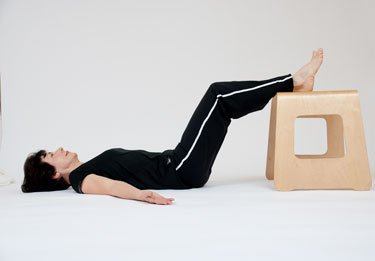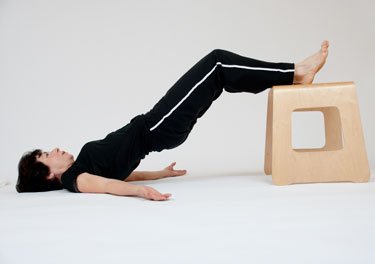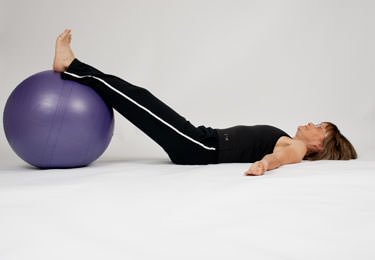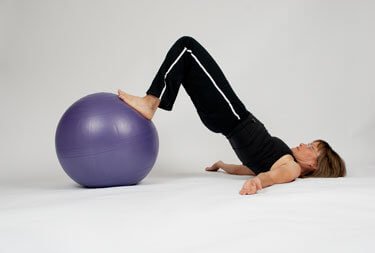Table of Contents
The hip area is often at risk of a fracture for people with osteoporosis, osteopenia and low bones density. There are several exercises that target the bones and muscles in the hips and can help to reduce the risk of a fracture. One to consider is the hip raise. In this blog, I demonstrate five variations of the hip raise exercise for individuals with osteoporosis. At the end of this post, I mention some exercise progressions beyond the hip raises.
We start with the basic hip raise exercise. From there we move through the remaining variations — each progressively more challenging than the one before. Before we start with exercise details, let’s cover the benefits of strengthening the hip area.
Benefits of Hip Exercises for Individuals with Osteoporosis
Hip strength has many benefits, especially for older adults with osteoporosis, knee pain or osteoarthritis. The key benefits are:
- Improved balance, leading to a reduction in the risk of a fall.
- Reduced severity of injury from a fall.
- Increased strength in spine and hip muscles.
How to Strengthen the Muscles Around Your Hip Bones
Progressive resistive exercise training is one of the most effective ways to strengthen the muscles around your hip bones. In a review published in 2019 in the Brazilian Journal of Physiotherapy, Professor Robin Daly and colleagues identify “progressive resistance training [as] the most effective strategy to improve various non-skeletal risk factors for fracture, particularly skeletal muscle mass, size and strength, and thus should form the basis of any exercise programs designed to reduce fracture risk.” (1)
In the book Primer on the Metabolic Bone Diseases and Disorders of Mineral Metabolism, Daly and Giangregario provide further detail and state (2) that when it comes to progressive resistive exercise training, individuals should:
- Begin with slow, controlled movements. Emphasis should first be on correct technique.
- Once you have mastered the movement, the intensity should progress to 75 to 85% of your 1 repetition maximum.
- Work at an intensity of 7 or 8 on a scale of 1 to 10. This would be considered hard or very hard.
They recommend that your strength program incorporate exercises that target muscles attached to, or that cross, the hip and spine. You should do at least 2 sets of 8 to 12 repetitions and have 1 to 3 minutes of rest between sets. (2)
In addition, nutrient intake, which includes calcium, Vitamin K2, and Vitamin D, should be optimized to supplement the effectiveness of progressive resistive exercise on bone health. (3)
Exercises for Osteoporosis of the Hip
The following are the five progressive exercises for osteoporosis of the hip. Each of these is a hip raises exercise.
- Active Hip Raise Exercise with Feet on Chair
- Athletic Hip Raise Exercise with Feet on Stability Ball
- A Position • Elite Advanced Hip Raise Exercise with Feet on Stability Ball
- B Position • Elite Advanced Hip Raise Exercise with Feet on Stability Ball
- C Position • Elite Advanced Hip Raise Exercise with Feet on Stability Ball
Let’s start with the first exercises for osteoporosis of the hip, the Hip Raise Exercise with Feet on Chair for individuals at an Active level.
Hip Raise Exercise with Feet on Chair • Active
The Hip Raise Exercise with Feet on Chair is an Active level strength exercise targeted at the hamstrings, buttocks, back, hips and spine. This hip raise exercise is the first of five exercises for osteoporosis of the hip.
Preparation
The following are the instructions for Hip Raise Exercise with Feet on Chair, the first of the exercises for osteoporosis of the hip.
You need a chair for this hip raise exercise. If you don’t have a padded chair, you can put a folded towel or mat over the chair.
- Lower yourself safely onto the floor
- Roll onto your shoulder before you roll over onto your back.
- Roll onto your back.
- Place your feet onto the chair.
- Place your hands away from your body with your palms up.

Instructions
- Take a breath in.
- Begin to slowly blow out as you lift your hips.
- As your hips lift, tuck your shoulder blades further to take the weight.
- Lift to a comfortable height.
- Aim to create a straight line from your shoulders, hips, and the back of your knees.
- Inhale as you slowly return to your start position.
- Complete your set.
Tips
A couple of tips.
- To reduce the intensity, begin by placing your calves on the chair (as opposed to your heels).
- You want to insure that your kneecaps and toes face the ceiling.
- Transfer the weight onto your shoulder. Do not transfer the weight onto your neck.
- If you need a little support under your head, then please use it in this exercise.
- Do not straighten your knees all the way. When you come up, you will have a little bend in your knees and that allows you to get a lot more focus on the hamstring exercise.

Hip Raise Exercise with Feet on Stability Ball • Athletic
This Hip Raise exercise with feet on stability ball is an Athletic strength exercise from the Exercise for Better Bones program. This exercise targets muscles in the buttocks, back and hamstrings and bones in the hips and spine. I demonstrate this exercise in the video below. This hip raise exercise is the second of five exercises for osteoporosis of the hip.
Make sure that you use a burst resistant exercise or Physio ball when you perform this exercise. I discuss how to use a burst resistant ball on this site.
Preparation
For good body mechanics you want to get used to lying down from your side, when you get onto the ball, or when get your legs up on to the ball.
- Keep one hand on the ball as you get down onto the floor
- Roll onto your shoulder before you roll over onto your back.
- Roll the ball into position under your lower legs and heels.
- To reduce the intensity, begin by placing your calves on the chair (as opposed to your heels).
- Arms — when starting this exercise — are palms up and 45 degrees away from your body.
- You want to ensure that your toes and your knee caps point to the ceiling.
- Your feet are at comfortable distance apart, usually about four to six inches. The more narrow, the more challenging it will be.
Instructions
- Take a breath in.
- Begin to slowly blow out as you lift your hips.
- As your hips lift, tuck your shoulder blades further to take the weight.
- Lift to a comfortable height.
- Aim to create a straight line from your shoulders, hips, and the back of your knees.
- Inhale as you slowly return to your start position.
- Complete your set.

Exercise Recommendations for Osteoporosis
Exercise is an essential ingredient to bone health. If you have osteoporosis, therapeutic exercise needs to be part of your osteoporosis treatment program.
But what exercises should you do and which ones should you avoid? What exercises build bone and which ones reduce your chance of a fracture? Is Yoga good for your bones? Who should you trust when it comes to exercises for osteoporosis?
A great resource on exercise and osteoporosis is my free, seven day email course called Exercise Recommendations for Osteoporosis. After you provide your email address, you will receive seven consecutive online educational videos on bone health — one lesson each day. You can look at the videos at anytime and as often as you like.

I cover important topics related to osteoporosis exercise including:
- Can exercise reverse osteoporosis?
- Stop the stoop — how to avoid kyphosis and rounded shoulders.
- Key components of an osteoporosis exercise program.
- Key principles of bone building.
- Exercises you should avoid if you have osteoporosis.
- Yoga and osteoporosis — should you practice yoga if you have osteoporosis?
- Core strength and osteoporosis — why is core strength important if you have osteoporosis?
Enter your email address and I will start you on this free course. I do not SPAM or share your email address (or any information) with third parties. You can unsubscribe from my mail list at any time.
Elite Position A • Advanced Hip Raise Exercise with Feet on Stability Ball
This exercise is a progression from the Athletic Level Hip Raise exercise. I encourage you to make one change at a time until you reach the intensity that challenges you.
To increase the intensity of the exercise, have less leg on the ball until it is just your heels on the ball. Bring your arms away from the start position. As you move your arms away from the 45 degree start position, more stability will be required. From the starting position, move your arms to 90 degrees, to 120 degrees, and eventually to straight overhead.
Be sure to tuck your shoulder blades down into the floor. This will be the hardest version of the position A elite level.
Make sure that you use a burst resistant exercise or Physio ball when you perform this exercise. I discuss how to use a burst resistant ball on this site.

Reminders
- Remember to keep a little bend in your knees as you lift and lower.
- As you come down, draw your pelvis down towards the ball. This movement causes a traction effect.
Elite Position B • Advanced Hip Raise Exercise with Feet on Stability Ball
The Hip Raises Position B is a strength exercise from the Exercise for Better Bones program specifically designed for the Elite Level. The exercise targets the muscles of the hamstrings, back, and buttocks. It also targets the bones in the spine and hips. This hip raise exercise is the fourth of five exercises for osteoporosis of the hip.
Make sure that you use a burst resistant exercise or Physio ball when you perform this exercise. I discuss how to use a burst resistant ball on this site.
Preparation
As in position A, roll down through your side, taking the ball with you. Position B builds on position A. Return your arms to 45 degrees to begin your position B.
Instructions
Rest your heels on the ball as you keep your knee caps and toes pointing straight to the ceiling. Take your breath in. Begin to gently blow as you:
- Raise your hips just as you did in position A.
- At the height of your hip raise, roll the ball in towards you.
- As you roll it in towards you, ensure that you drive your weight through your shoulder blades.
- Aim to get a straight line between the shoulder, hip, and knee.
- Roll back out and down.
The intensity of this exercise can be modified by moving your arms away from your body and eventually doing it with your arms straight up overhead.

Exercise Recommendations for Osteoporosis
Exercise is an essential ingredient to bone health. If you have osteoporosis, therapeutic exercise needs to be part of your osteoporosis treatment program.
But what exercises should you do and which ones should you avoid? What exercises build bone and which ones reduce your chance of a fracture? Is Yoga good for your bones? Who should you trust when it comes to exercises for osteoporosis?
A great resource on exercise and osteoporosis is my free, seven day email course called Exercise Recommendations for Osteoporosis. After you provide your email address, you will receive seven consecutive online educational videos on bone health — one lesson each day. You can look at the videos at anytime and as often as you like.

I cover important topics related to osteoporosis exercise including:
- Can exercise reverse osteoporosis?
- Stop the stoop — how to avoid kyphosis and rounded shoulders.
- Key components of an osteoporosis exercise program.
- Key principles of bone building.
- Exercises you should avoid if you have osteoporosis.
- Yoga and osteoporosis — should you practice yoga if you have osteoporosis?
- Core strength and osteoporosis — why is core strength important if you have osteoporosis?
Enter your email address and I will start you on this free course. I do not SPAM or share your email address (or any information) with third parties. You can unsubscribe from my mail list at any time.
Elite Position C • Advanced Hip Raise Exercise with Feet on Stability Ball
The Hip Raises Position C is a strength exercise from the Exercise for Better Bones program specifically designed for the Elite Level. The exercise targets the muscles of the hamstrings, back, and buttocks. It also targets the bones in the spine and hips. This hip raise exercise is the last of five exercises for osteoporosis of the hip.
Make sure that you use a burst resistant exercise or Physio ball when you perform this exercise. I discuss how to use a burst resistant ball on this site.

Set Up
- Keep one hand on the ball as you get down onto the floor.
- Roll onto your shoulder before you roll over onto your back.
- Roll the ball into position so that your feet rest on the side of the ball closest to you.
- Place your arms 45 degrees away from your body with your palms to the sky.
- Tuck your shoulder blades underneath you.
- Rest your feet four to six inches apart. The more narrow, the more challenging it will be.
- Keep your toes and your knee caps pointing to the ceiling.
Instructions
- Take a breath in.
- Begin to slowly blow out as you lift your hips.
- As your hips lift, tuck your shoulder blades further to take the weight.
- Lift to a comfortable height.
- Aim to create a straight line from your shoulders, hips, and the back of your knees.
- Inhale as you slowly return to your start position.
- Complete your set.
Increase Intensity
The intensity of this exercise can be modified by moving your arms away from your body and eventually doing it with your arms straight up overhead.
Beyond the Hip Raise Exercise
Here is another exercise that you should consider. The squat, in its variations, has benefits that exceed those of the hip raise.
Why?
The hip raise exercise is done lying on the floor. The squat must be done standing. It incorporates weight bearing that the hip raise does not. As a result, there is more demand on your femoral neck during the exercise. This leads to an increase in bone density in the femoral neck region of the hip.
If you want more exercises to address osteoporosis in the hip, consider:
If you do any of these remember to practice proper squat technique.
The squat is a closed kinetic chain exercise. In a study (4) published in the Journal of Physical Therapy Science, the researchers determined “Osteoporotic postmenopausal women should be prescribed closed kinetic chain exercise to diminish the effects of the disease and minimize their risk of fall.” The squat fits the bill
I encourage you to read my blog, Can Osteoporosis be Reversed?, to learn about a study where squats were used to increase bone density and, in effect, reverse osteoporosis.
Additional Resources • Osteoporosis Exercises for Hips
Many of my clients have questions about osteoporosis exercises for hips. Here some additional resources you might find helpful on this topic:
References
- Daly, RM et al. Exercise for the prevention of osteoporosis in postmenopausal women: an evidence-based guide to the optimal prescription. Brazilian Journal of Physical Therapy 2019;23(2):170-180
- Daly RM, Giangregorio L. Exercise for Osteoporotic Fracture Prevention and Management. In: Bilezikian JP, ed. Primer on the Metabolic Bone Diseases and Disorders of Mineral Metabolism. 9th ed. John Wiley & Sons, Inc.; 2019: Chapter 67, 517-525.
- Beck BR, Daly RM, Singh MA, Taaffe DR. Exercise and Sports Science Australia (ESSA) position statement on exercise prescription for the prevention and management of osteoporosis. J Sci Med Sport. 2017;20(5):438-445.
- Thabet AAE, Alshehri MA, Helal OF, Refaat B. The impact of closed versus open kinetic chain exercises on osteoporotic femur neck and risk of fall in postmenopausal women. J Phys Ther Sci. 2017 Sep;29(9):1612-1616
Osteoporosis Exercise Plan
Visit my Osteoporosis Exercise Plan page for more information on this topic.

Comments